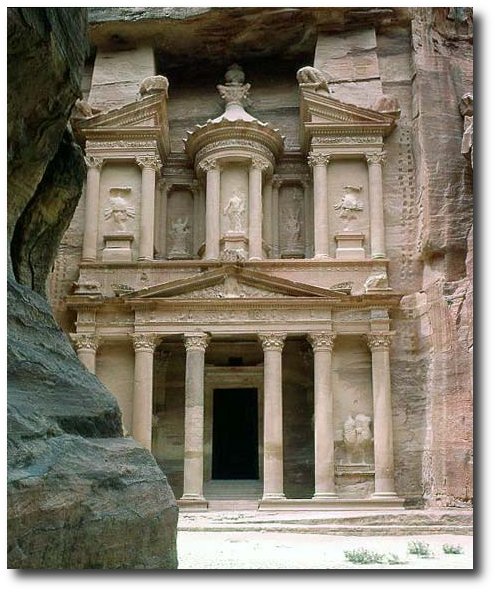Petra Jordan
As time goes by Christians have to just smile bigger smiles as more evidence comes out and CONFIRMS the Bible. No other Religion has the evidence that Christianity does. The Old Testament is being confirmed down to the very smallest detail.
A relatively small part of the remains of the biblical world has been excavated. Of some 5,000 known sites of archaeological significance in Palestine, only about 350 have been excavated, and of these only about 2 percent have been extensively excavated. Of those that have been excavated, it is a fact that the entire Bible holds a remarkable track record of accuracy when compared with the finds unearthed through archaeology.
Mario Seigliehttp://www.faithfacts.org/search-for-truth/maps/archaeological-and-external-evidence
Archaeologist Nelson Glueck has concluded, “no archaeological discovery has ever been made that contradicts or controverts historical statements in Scripture”
Gleason Archer, a scholar of biblical studies and languages of recent years, writes about attributes of the Bible: “As I have dealt with one apparent discrepancy after another and have studied the alleged contradictions between the biblical record and the evidence of linguistics, archaeology, or science, my confidence in the trustworthiness of Scripture has been repeatedly verified and strengthened by the discovery that almost every problem in Scripture that has ever been discovered by man, from ancient times until now, has been dealt with in a completely satisfactory manner by the biblical text itself-or else by objective archaeological information” (Encyclopedia of Bible Difficulties, Zondervan, Grand Rapids, 1982, p. 12).
Frank E. Gaebelein, an eminently qualified author and general editor of The Expositor’s Bible Commentary, has remarked that “the attitude ofsuspended judgment toward Bible difficulties . . . is constantly being vindicated, as archaeology has solved one Biblical problem after another, and as painstaking re-examination of discrepancies has finally led to answers” (The Expositor’s Bible Commentary, Zondervan, Grand Rapids, 1979, Vol. 1. p. 31).
- Ebla Tablets The Clay Tablets date from around 2300 B.C. They demonstrate names in the Patriarchal accounts in the BIBLE are genuine. In use in Ebla was the name “Canaan,” a name critics once said was not used at that time and was used incorrectly in the early chapters of the Bible. The tablets refer to all five “cities of the plain” mentioned in Genesis 14, previously assumed to have been mere legends.
- Merneptah Stela—Dated c. 1200 BC to 12 07 BC is an inscription of the Egyptian Pharaoh Merneptah contains the earliest reference to a people called Israel.. (Merneptah was the pharaoh that ruled Egypt in 1212-1202 B.C.) The context of the stela indicates that Israel was a significant entity in the late 13th century B.C. Mesha stele – Discovered at Dhiban, Jordan (ancient Moab), in 1868.- The stele, erected by the Moabite king Meshe, mentions the Israelite king Omri and records vessels of YHWH received as tribute.
- In 1993, A 9th century B.C. inscription at Tel Dan. The words carved into a chunk of basalt refer to the “House of David” and the “King of Israel.” And the Bible’s version of Israelite history after the reign of David’s son, Solomon, is believed to be based on historical fact because it is corroborated by independent account of Egyptian and Assyrian inscriptions. Tel Dan Stele a city marking the northern boundary of the ancient kingdom of Israel. The stele contains an inscription by an Aramean king describing his victory over two other kings, one of them the king of Israel, the other a king described as being of the “House of David”. This represents the earliest known instance of this phrase from an archaeological context.
- The Assyrian Empire was a powerful empire. At the time of Jesus, no physical evidence of Nineveh was seen. YET, again, the Bible can be validated as true, as the excavations at Nineveh and other cities around the area produced a staggering amount of evidence including “tens of thousands of tablets” containing “an immense amount of data” (The Interpreter’s Dictionary of the Bible, Abingdon Press, Nashville, 1962, Vol. 1, s.v. “Assyria and Babylon,” p. 275). This is unique because at one time Nineveh was a laughing joke that it even existed. : “Nineveh has perished. No trace of it remains. No one can say where once it existed” (Magnusson, p. 175).
- The Hittites were once thought to be a biblical legend, until their capital and records were discovered in Turkey. An entire cache of Hittite legal documents from 1400 B.C. Confirms many details of Genesis, Deuteronomy
- In 1986 – An Ancient seal belonging to Baruch, son of Neriah, a scribe who recorded the prophecies of Jeremiah (Jer. 45:11).
- In 1990, Harvard researchers Unearthed a silver-plated bronze calf figurine reminiscent of the huge golden calf mentioned in the book of Exodus.
- It was once claimed there was no Assyrian king named Sargon as recorded in Isaiah 20:1, because this name was not known in any other record. Then, Sargon’s palace was discovered in Iraq. The very event mentioned in Isaiah 20, his capture of Ashdod, was recorded in the palace walls! Even more, fragments of a stela (a poetic eulogy) memorializing the victory were found at Ashdod itself.
- Another king who was in doubt was Belshazzar, king of Babylon, named in Daniel 5. The last king of Babylon was Nabonidus according to recorded history. Tablet was found showing that Belshazzar was Nabonidus’ son.
- 8th century BC Seal-impressions bearing the letters LMLK on jar handles, associated with the reign of the Biblical king Hezekiah of Judah.
- Found under controlled conditions by Gabriel Barkay during the excavation of an ancient burial chamber found was Ketef Hinnom scrolls. They were two small silver scrolls containing texts similar to, although not identical with, the Priestly Blessing from the Book of Numbers and parallel verses of Exodus (20:6) and Deuteronomy (5:10 and 7:9). They have been dated Immediately prior to 586 BC.
- Shechem temple Dated Late Bronze Age to Early Iron Age Cf. the “House of (the god) Baalberith” in Judges 9.
- Dated Iron Age Tumuli located west of Jerusalem The 19 tumuli dating to the Judean monarchy possibly represent sites of memorial ceremonies for the kings as mentioned in 2 Chronicles 16:14, 21:19, 32:33, and the book of Jeremiah 34:5
- Boundary markers for Gezer walls and city gate. 1st century BC Hebrew inscriptions found engraved on rocks several hundred meters from the tel read “boundary of Gezer.”
- Balaam texts Found during controlled excavations at Deir Alla, Jordan. The texts (painted in ink on a plastered wall and painstakingly reconstructed) describe the visions of seer named Balaam (cf. Numbers 22–24)
- Black Obelisk of Shalmaneser III The obelisk depicts Jehu, son of Omri, king of Israel, and also mentions Hazael of Aram/Damascus/Syria (cf. 2 Kings 8–10)
- “Goliath” The ostracon (pottery fragment) is incised with nine letters representing two names (אלות and ולת) etymologically related to Goliath
- Herod’s tomb at Herodium
- Izbet Sartah ostracon – Dated 1200 – 1000 BC – 5 incised lines of 80–83 letters (readings of epigraphers vary), the last line being an abecedary.
- Jehoiachin’s Rations Tablets –Dated 6th century BC Excavated from Babylon during 1899–1917 by Robert Koldewey, stored in a barrel-vaulted underground building consisting of rows of rooms near the Ishtar Gate
- Lachish ostraca -The ostraca (inscribed pottery fragments) describe conditions in Judah shortly before the first Babylonian invasion. Letter #3 mentions a warning from the prophet; letter #4 names Lachish and Azekah as among the last places being conquered (cf. Jeremiah 34:7); letter #6 describes a conspiracy reminiscent of Jeremiah38:19 and 39:9 using phraseology nearly identical to Jeremiah 38:4.
- Nebo-Sarsekim Tablet The tablet mentions a Babylonian official (Nebo-Sarsekim) who may be a identical with Sarsekim, an official mentioned in Jeremiah 39:3.
- Pim weights – Found at Gezer; many others found since. Inscribed with a translation of 1Samuel 13:21
- Lachish Reliefs Found during excavations of Sennacherib’s palace at Nineveh The reliefs depict the Assyrian conquest of Lachish.
- Pontius Pilate Found in secondary use in a stairway of the Roman theater in Caesarea Insribed : “The prefect of Judaea, Pontius Pilate, erected the Tiberium (in honor of Tiberius Caesar)”
- Sargon II’s Conquest of Samaria inscription Found at Khorsabad (modern Iran) in 1843 The inscription reads: “I besieged and conquered Samaria, led away as booty 27,290 inhabitants of it. … The town I rebuilt better than it was before and settled therein people from countries which I myself had conquered.” ( 2 Kings 17:23–24).
- Tiglath-Pileser III’s inscriptions Found at Nimrud “I received the tribute of … Jehoahaz of Judah” (incident not mentioned in the Bible); ANET 283: “As for Menahem I overwhelmed him … I placed Hoshea as king over them.” ( 2 Kings 15:19 and 17:3)
- Zayit Stone Limestone boulder incised with a abecedary and remnants of other inscriptions in a South Canaanite development of the basic Phoenician script common to the Palestinian Levant. The wall in which the boulder was found was sealed by a destruction layer dated to the 10th century BC, but the inscription pre-dates the destruction layer and may belong to the early-mid 11th century BC.
- Elephantine papyri Upper Egypt. The papyri are not from controlled excavations but their authenticity is undoubted. The papyri are from a Jewish community living in Egypt during the Persian Empire. They record, among other matters, the relationship of this community with the Temple in Jerusalem
- Kurkh Monolith Discovered by J.E. Taylor at Diyarbekir, Turkey, in 1861. This monolith of Shalmaneser III mentions “2,000 chariots, 10,000 foot soldiers of Ahab the Israelite”
- Siloam inscription in the Hezekiah tunnel, Jerusalem.- The tunnel was documented by Robinson in 1838,but the inscription (near the centre of tunnel, where the two work-gangs met) was not discovered until 1880. It was removed from Jerusalem the same year, and is presently in the Archaeological Museum at Istanbul.- The inscription records the completion of the tunnel, intended to bring water into.
Norman Geisler, professor of theology, summarizes the findings of archaeology: “In every period of Old Testament history, we find that there is good evidence from archaeology that the Scriptures speak the truth. In many instances, the Scriptures even reflect firsthand knowledge of the times and customs it describes. While many have doubted the accuracy of the Bible, time and continued research have consistently demonstrated that the Word of God is better informed than its critics” (Baker Encyclopedia of Christian Apologetics, 1998, p. 52).







